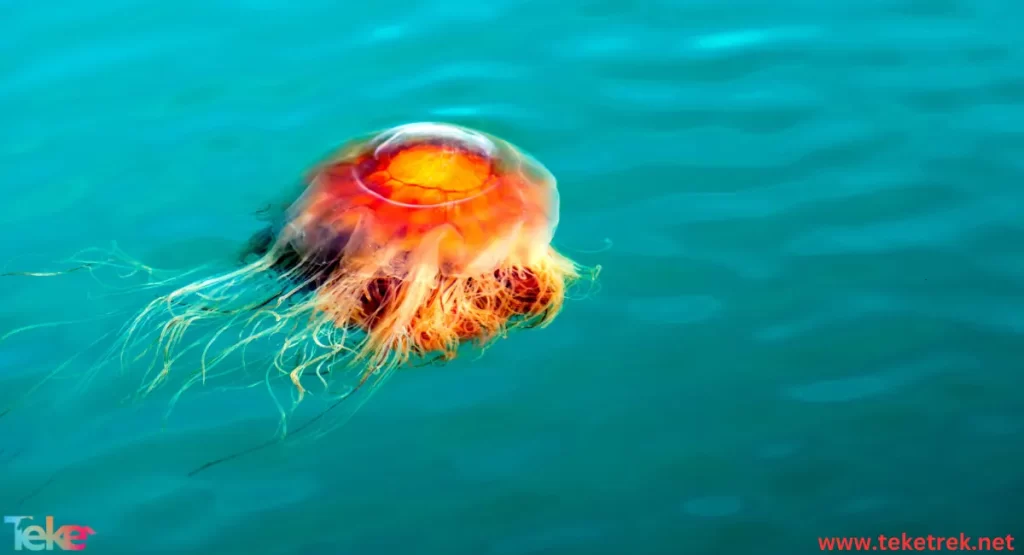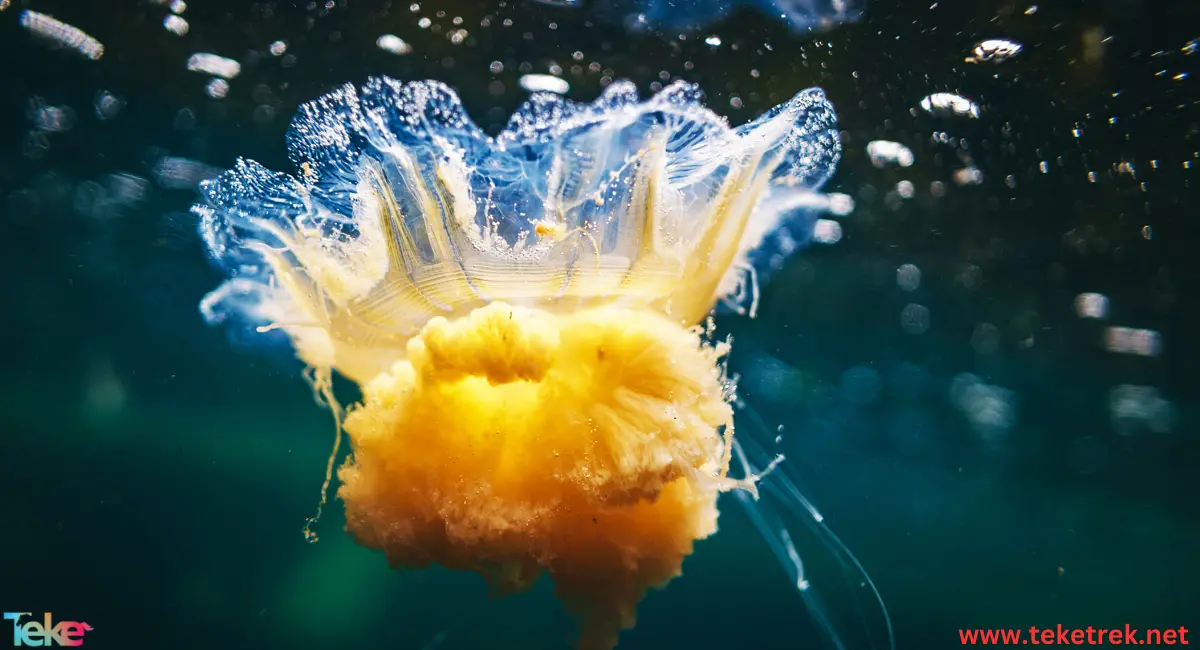The lion’s mane jellyfish is one of the wonderful and exciting marine creatures that live in oceans and seas around the world.
The lion’s mane jellyfish is distinguished by its beautiful shape and bright colors that attract the attention of many.
The lion’s mane jellyfish is one of the most famous types of jellyfish due to its unique appearance and strange behavior in the world of marine life.
The process of lion’s mane jellyfish reproduction is an interesting topic, as this process is characterized by complexity and mystery. Jellyfish reproduction involves several stages and exciting mechanisms that make this aquatic organism the focus of interest for many biologists and marine life lovers.
Through this article from teketrek, we will explore the world of the lion jellyfish and learn about different aspects of its life and behavior, in addition to exploring its reproductive process and its importance in the life cycle of this charming marine creature.

An introductory overview of the lion’s mane jellyfish:
The lion’s mane jellyfish, or lion’s mane jellyfish (Cyanea capillata), is a type of jellyfish, considered the largest jellyfish in the world.
The body of the lion’s mane jellyfish reaches 3 meters in width, and its tentacles reach 37 meters in length. The largest type of jellyfish was explored in 1864 and reached 55 meters in length.
The lion’s mane jellyfish belongs to the phylum Cnidaria, the subphylum Medusa, of the phylum Cnidaria.
What is the reason for naming the lion’s mane jellyfish?
The lion’s mane jellyfish is named after its “mane” with long, hair-like tentacles that hang from the lower side of its body in the shape of a bell.
Locations of the lion’s mane jellyfish
The distribution range of the Lion’s Mane Jellyfish is limited to the cold northern waters of the Arctic, North Pacific, and North Atlantic Oceans.
What is the food of the lion’s mane jellyfish?
Some species of lion’s mane jellyfish can take advantage of small particles in the water such as microorganisms, zooplankton, and small fish, which they capture using their smooth arms.
These particles and small organisms are part of the lion’s mane jellyfish’s diet and contribute to its nutrition.
Reproduction stages of the lion’s mane jellyfish:
The lion’s mane jellyfish reproduces in March and early May through external fertilization. Its larvae settle on the sea floor and develop into polyps that grow into jellyfish within 30 to 40 days.
The most important facts about the lion’s mane jellyfish:
The lion’s mane jellyfish is considered one of the largest types of jellyfish in the world.
The average length of the lion’s mane jellyfish is about (40 cm), and can reach (200 cm).
The lion’s mane jellyfish is named because it has long, hair-like tentacles hanging from its bell.
The lion’s mane jellyfish contains about 1,200 tentacles divided into 8 groups.
The lion’s mane jellyfish hunts by extending its tentacles and creating a trap that captures prey including fish and crustaceans.
The lion’s mane jellyfish causes a powerful sting that can be painful to humans.
the benefit of the lion’s mane jellyfish:
The lion’s mane jellyfish plays an important role in the marine ecosystem and provides many environmental benefits, including:
1. Ecosystem balance: The Lion’s Mane jellyfish is considered an essential part of the food chain in the marine environment, as it feeds on small fish and invertebrates, and thus contributes to regulating the number of these creatures and maintaining the balance of the ecosystem.
2. Cleaning water: The lion’s mane jellyfish is considered a natural water cleanser, as it feeds on organic molecules and waste in the ocean, which helps in purifying the water and improving its quality.
3. Coral protection: Although lion’s mane jellyfish can be harmful to coral if their numbers increase significantly, their presence can help prevent the spread of other types of jellyfish that are more harmful to coral.
4. Attracting tourists: The presence of lionfish jellyfish in the oceans may be an attraction for tourists and divers, which contributes to supporting the marine tourism industry and preserving biodiversity in the region.
If lionfish jellyfish populations are well controlled, they can have a positive impact on the environment and ecosystem in general.

important procedures to preserve lion’s mane jellyfish
To preserve lionfish jellyfish and ensure their continued presence in the marine environment, some important procedures must be followed. Among these procedures:
1. Protecting natural habitats: The environment of the lion’s mane jellyfish must be preserved and kept clean and healthy, such as protecting corals and coral reefs that are home to the lion’s mane jellyfish.
2. Reducing environmental pollution: Sources of environmental pollution, such as plastic and chemical pollution, which can negatively affect the health of lionfish jellyfish and their surrounding environment, must be reduced.
3. Regulating fishing: Fishing operations must be regulated and legalized to ensure that they do not negatively affect the numbers of jellyfish.
4. Awareness and education: Awareness and education must be increased about the importance of protecting lionfish jellyfish, and the importance of preserving biological diversity in the oceans.
5. Measures to maintain environmental balance: Measures must be taken to maintain environmental balance in the oceans, such as preventing climate change and confronting pollution and unsustainable fishing phenomena.
By following these measures and adopting sustainable behaviours, we can contribute to protecting the lion’s mane jellyfish and maintaining the balance of the marine environment.
In short, the Lion’s Mane Jellyfish represents an important part of the ocean’s biodiversity and is an indicator of the health of the marine environment. So, we must all come together to protect this wonderful marine creature and preserve its natural habitat.





